

Bone-conduction type hearing aid, c1850-1900
- Made:
- 1850-1900 in unknown place




Audiphone or dentaphone-type hearing aid, with oak handle and stiffened rubberised board, a form of bone-condution hearing aid whereby sound vibrations can be detected when it's held against the users teeth, c.1850-1900.
Conductive hearing loss is one of several ways in which an individual’s can be reduced or lost. It happens when sounds are unable to pass from the outer ear to the inner ear. As such, older forms of hearing aid such as ear trumpets and conversation tubes were of limited use. This device was one of a small number developed in the 19th century for use by those with conductive hearing loss, and it took a very different approach to relaying sounds.
It had long been noted that sound could be detected via bones or teeth when they touched materials that vibrated in response to that sound. This device exploits that principle by means of a flat, hardened rubber sheet attached to a handle. When ‘listening’, the user faced the noise source and, holding the device beneath the chin rested the top edge of it against their upper front teeth. Some designs, including this one, had a looped thread attached which allowed the user to keep the sheet in a more taut, curved shape so as to allow more subtle vibrations.
The audiphone and the dentaphone, which both appeared in 1879, were patented examples of hearing aids that used this technique. But other similar devices were produced, on both side of the Atlantic, that followed similar designs.




